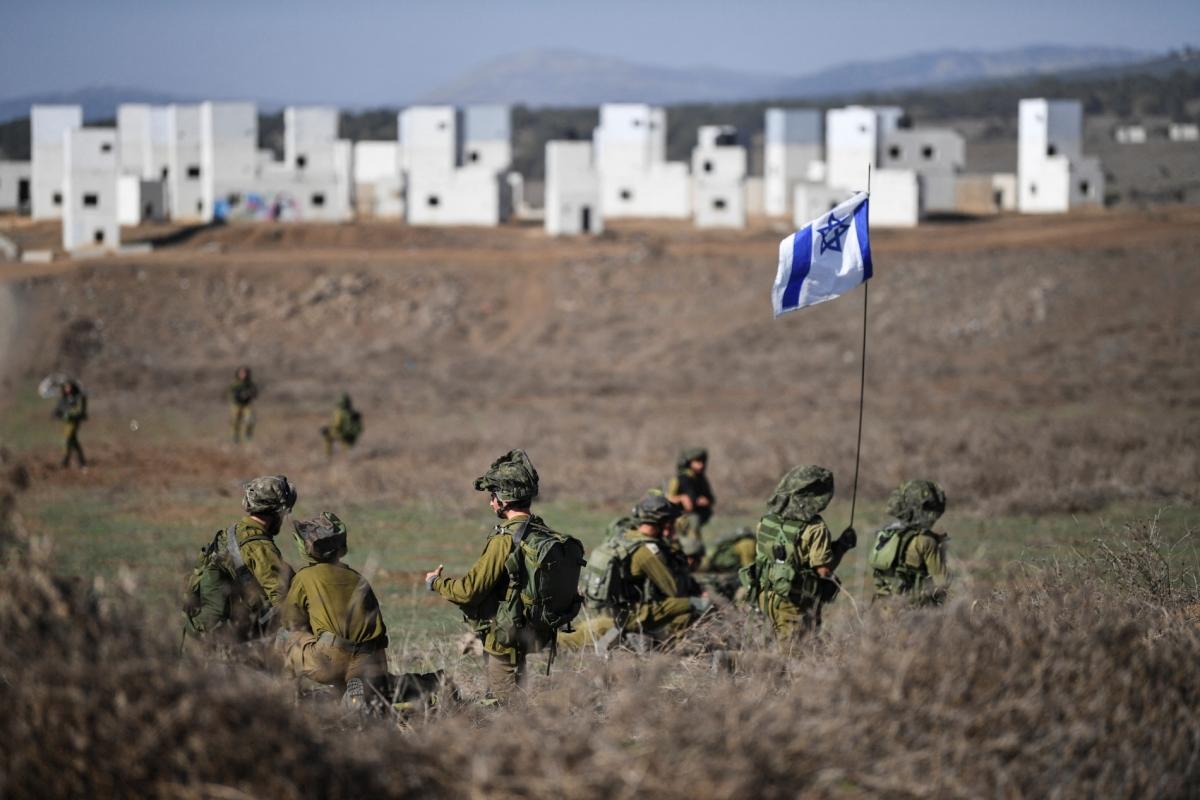IDF ground forces stay in northern Gaza as incursion expands YAAKOV LAPPIN

Former military intelligence chief Amos Yadlin: “If Sinwar thinks he can play for time, he's absolutely wrong.”
Israel Defense Forces ground forces that entered northern Gaza on Friday night remained there on Saturday, marking what appears to be the start of the Israeli ground offensive, as opposed to earlier brief raids.
“In Gaza, we are proceeding with the stages of the war. IDF forces entered northern Gaza and broadened the ground activities,” IDF Spokesperson Rear Adm. Daniel Hagari said on Saturday.
Infantry, Armored Corps and Combat Engineering Corps units all entered the Strip, supported by heavy artillery.
Meanwhile, the Israeli home front continued to face rocket fire from Gaza, with volleys fired at greater Tel Aviv and Beersheva on Saturday. A rocket scored a direct hit on a home in Beersheva, but no injuries were reported, as civilians evacuated to safe rooms as warning sirens pealed.
Meanwhile, Hagari said, the Israel Air Force continued “massive highly significant air attacks and the killing of senior Hamas commanders.”
Acting on Military Intelligence and Israel Security Agency (Shin Bet) information, Israeli fighter jets on Saturday killed Ratib Abu Tzahiban, the commander of Hamas’s Gaza City Brigade’s Naval Forces.
Tzahiban planned and commanded a maritime infiltration attempt on Oct. 24 that the Israel Navy thwarted, said the military.
Additionally, Israeli Navy sailors and the IAF provided support to IDF ground forces and struck numerous Hamas terrorist targets from the air and the sea, the military said. Among these targets were observation posts, anti-tank missile launchers and a “military” compound.
Overnight, fighter jets also killed Asem Abu Rakaba, the head of Hamas’s Aerial Array.
Abu Rakaba was responsible for Hamas’s unmanned aerial vehicles, drones, paragliders, aerial detection and aerial defense, the IDF said.
“He took part in planning the massacre in the communities surrounding the Gaza Strip on Oct. 7. He directed the terrorists who infiltrated Israel on paragliders and was responsible for the drone attacks on IDF posts,” the army said.
Hagari said that senior field tactical Hamas commanders are being eliminated, advancing Israel’s war goals.
There were no injuries reported to Israeli ground forces thus far.
“We are working, with the objectives of destroying Hamas, returning hostages and restoring national security. These guide us as we move and take operational decisions, with these goals being our compasses,” he said.
At the humanitarian level, Gazan civilians continue to move south beyond Wadi Gaza, where Israel is allowing more trucks carrying food water and medicines into southern Gaza from Sinai. “Those who will go to this protected place will receive food, medicine and water,” said Hagari.
The New York Times reported on Saturday that Israel’s assertion that Hamas is stockpiling fuel and food in Gaza, and keeping it away from civilians was confirmed by Arab and Western officials, who said the stockpiles are being kept in Hamas’s enormous underground tunnel network.
“Hamas has hundreds of thousands of gallons of fuel for vehicles and rockets; caches of ammunition, explosives and materials to make more; and stockpiles of food, water and medicine,” the Times stated.
The Galilee
In northern Israel, several anti-tank missile and mortar shell launches were identified from Lebanese territory towards Israel on Saturday, including at IDF posts along the border. The attacks hit open areas.
IDF tanks and artillery responded with fire towards the origin of the attacks and struck Hezbollah military infrastructure in Lebanon, the army said.
On Saturday afternoon, a terrorist cell attempted to fire anti-tank missiles from Lebanon towards the western sector of the border, near Kibbutz Hanita. An IDF UAV struck the cell.
In Judea and Samaria, the IDF has deployed a large number of troops, said Hagari. The IDF is conducting a series of security raids against Hamas in the region.
Addressing claims of hostage exchange deals in the works, Hagari described them as “cognitive terrorism meant to influence our population on such a sensitive area.” The IDF works with the Hostage and Missing Persons Headquarters to provide “real information” to families when it is received, he said.
Maj. Gen. (res.) Amos Yadlin, former head of IDF Military Intelligence and former IAF deputy commander, told journalists on a call organized by MediaCentral, a nonprofit, Jerusalem-based media liaison service, that the ground operation was delayed until out of a desire for the air campaign to weaken Hamas as much as possible, to call up and train reserves, and to provide them updated intelligence.
A request from the United States, which is concerned about attacks on its forces in Syria, Iraq and the Persian Gulf, for more time, also played a role in delaying the ground offensive, Yadlin said.
“According to my impression, it started last night, even though it is not a full-scale attack, it’s a low-intensity conflict. It’s inch by inch, meter by meter, trying to avoid casualties and trying to kill as many Hamas terrorists as possible,” he said.
“I guess that most of them [the terrorists] will flee to the tunnels, and then the challenge is to destroy these tunnels to get them out using one technique or another,” said Yadlin.
Hamas was not considered to be the top threat to Israel, coming after Iran, its nuclear program and Iranian entrenchment, and was seen as an entity to be weakened but kept as an address that controls Gaza, he noted.
“Since Oct. 7, this paradigm was found to be wrong, and replaced with a paradigm of Nazi Germany and ISIS. Like those, Hamas “should be destroyed as a state, Hamastan should be destroyed,” Yadlin said.
“It is not a blitzkrieg, it is not a Six-Day War, it is a long, low-intensity conflict, but the goal is very clear. At the end of the day, very much like Nazi Germany disappeared or the Islamic caliphate, which lasted from 2014 to 2019 until the United States destroyed it in Iraq and northern Syria,” Hamas too will be destroyed as a terror army and regime.
“This is the directive that the IDF got from the government,” said Yadlin.
Destruction of Hamas
In defining what the destruction of Hamas would look like, he estimated that some 10,000 out of the 27,000 terrorists of the Hamas army would need to be killed, that its command-and-control systems stop functioning, that Hamas chief in Gaza Yahya Sinwar and “military” wing chief Mohammed Deif are targeted, and that some additional senior Hamas commanders are willing to leave the Gaza Strip, “as Arafat left Beirut in 1982.”
This would be realistic if conditions around Israel allow enough time, said Yadlin, noting that external factors like American pressure to end the war due to a humanitarian crisis, or the north erupting, could change the time factor.
Israel is employing an air campaign, a siege and a ground campaign to achieve these goals, he said.
“We saw a very serious air campaign, striking every target command post, intelligence center, anti-tank teams, anti-aircraft teams, terrorist chiefs, their tunnels, their supply—everything is a target. To avoid collateral damage people were asked to move to the southern part of Gaza, and anyone who stayed is in a way a human shield for the terrorists,” said Yadlin.
It is possible to both advance the goal of destroying Hamas and to secure the release of the 229 hostages being held by it at the same time, he argued.
“It is clear Sinwar understood Israel would launch ground maneuver and he tried to take advantage of it [the hostage situation] by a long process of negotiations, releasing two hostages a week. At this pace, it would take two years. Israel would not accept it, and in a way what I think the [current] maneuver is telling Sinwar is you cannot stop the maneuvering and you will pay even more if you don’t do a serious substantial deal, at least the kids, the 9-month baby, the 4-year-olds whose parents were killed, the women raped over and over again, and maybe again now: We want these civilians to be returned as soon as possible. If Sinwar thinks he can play the time and stop the maneuver, he’s absolutely wrong,” Yadlin said.
“Sinwar is now also under pressure from people in his own terrorist movement, saying, ‘We went too far, let’s do a deal or Gaza will very soon be like Dresden [in 1945]. But he is not paying so much attention. The people of Gaza is not his interest. He cares about jihadist ideology that [promotes the goal of] ‘We will kill all the Israelis,’” Yadlin added.
Sinwar is “very frustrated that the rest of the fronts haven’t erupted,” he added.
Hezbollah chief Hassan Nasrallah is still at the stage of showing “minimum support for Sinwar,” Yadlin continued. Nasrallah “said he would go up to level 2 if Israel attacks on the ground. We have to see what he’s planning for the next days.
“Level 3 is a full-scale war,” something Hezbollah is “absolutely not interested in,” Yadlin argued. “Fifty Hezbollah terrorists are already killed, some before and some after firing anti-tank missiles. He may move to another mode and we have to be ready. But the [IDF] Northern Command is ready. He sees that fighting against the Syrian opposition [on behalf of the Assad regime in the civil war] is easier than fighting the IDF when the IDF is ready.”
Israeli Defense Minister Yoav Gallant on Saturday directed the defense establishment to continue striking above and below ground in Gaza and to continue its efforts to detect and eliminate Hamas terrorists, both leadership and operatives.
“I completed a situation assessment. Last night we completed a phase in the war. We will continue to be strong and precise, and hunt down every terrorist,” said Gallant.

- Art
- Causes
- Analysis
- Cloak & Dagger
- Economy - Finance
- Health
- Literature
- Music
- Other
- News & Politics
- Real Time Facts
- Sports



